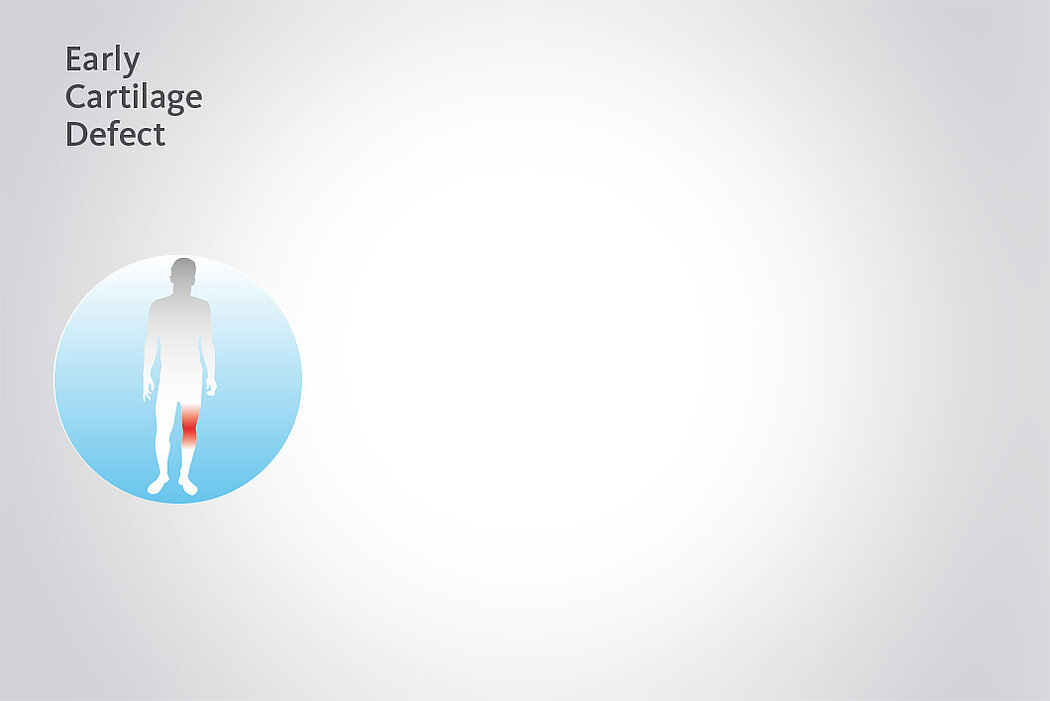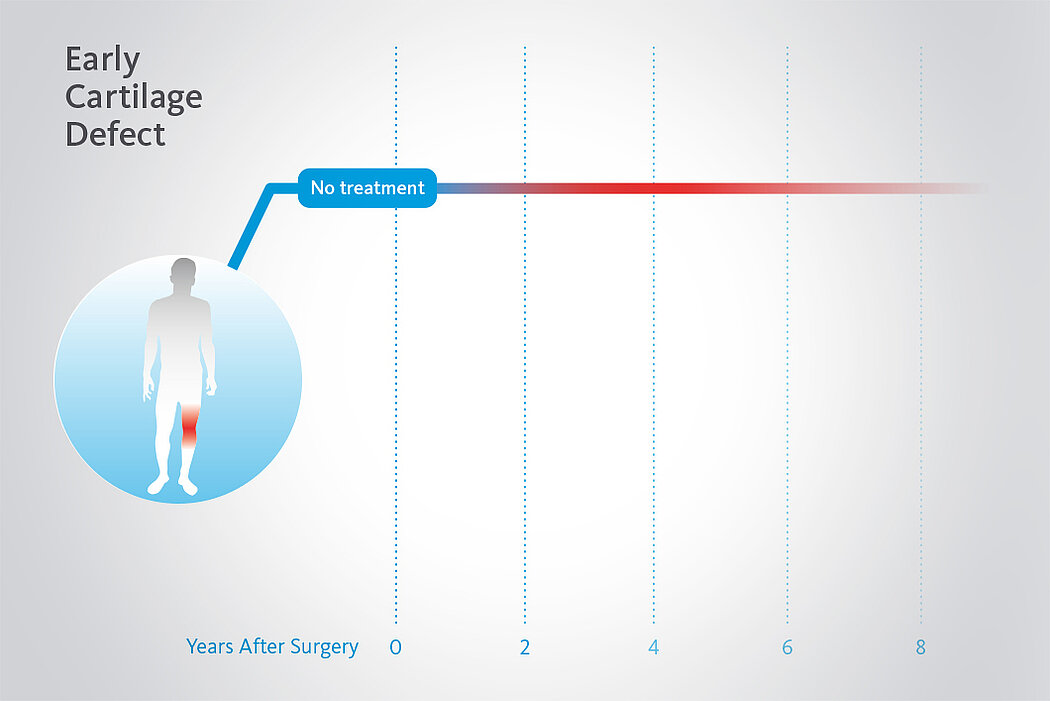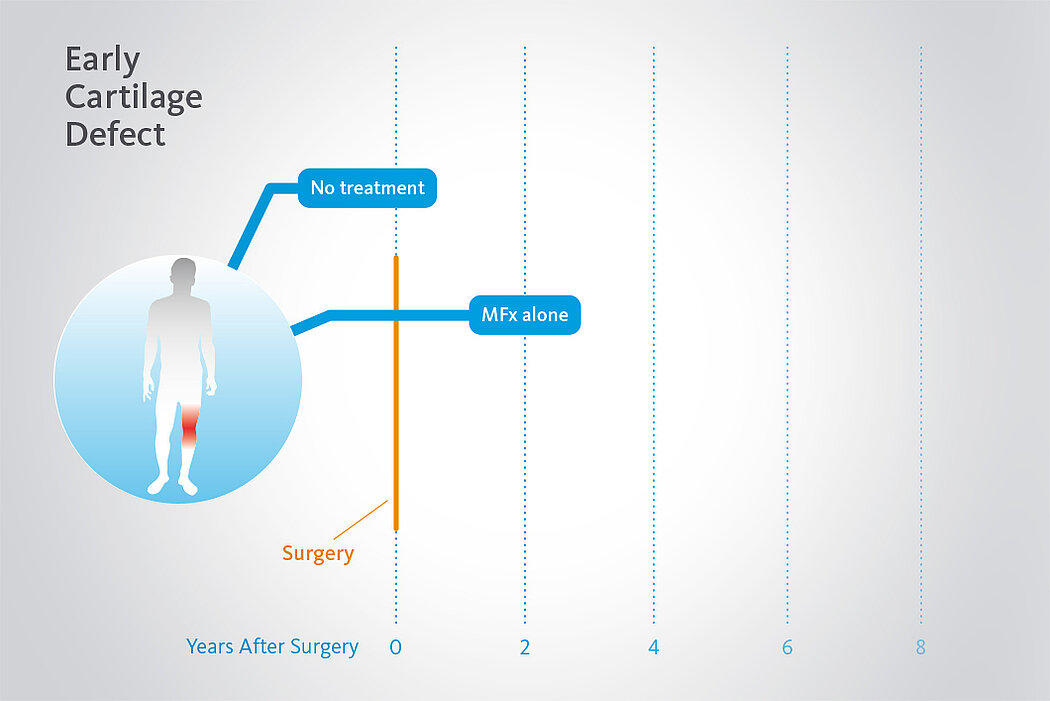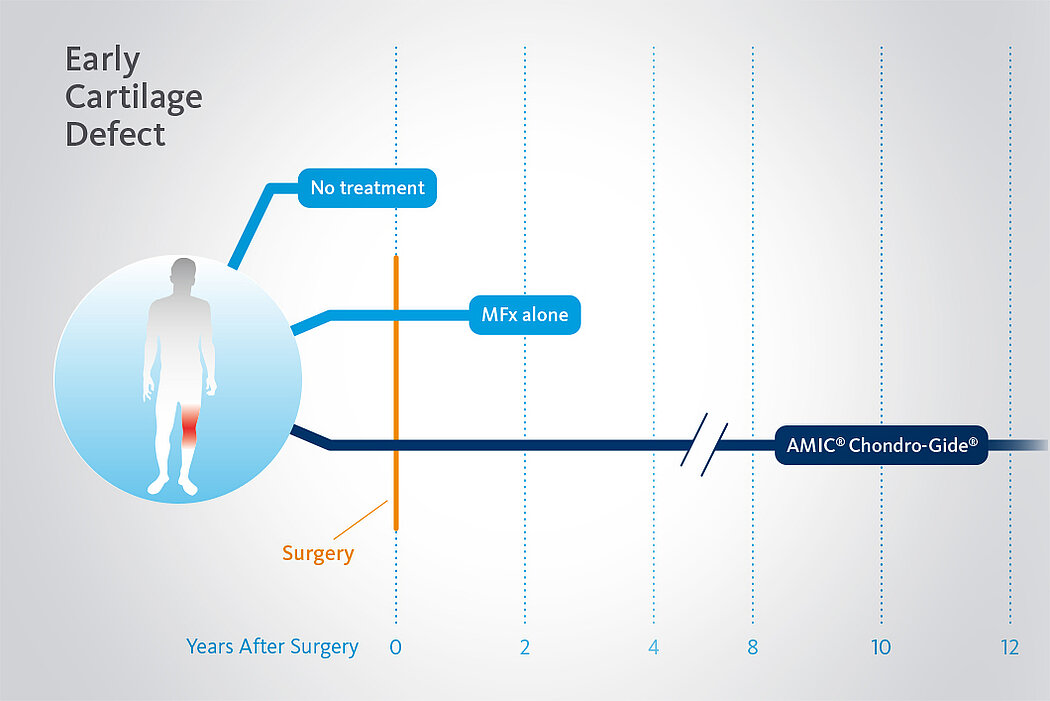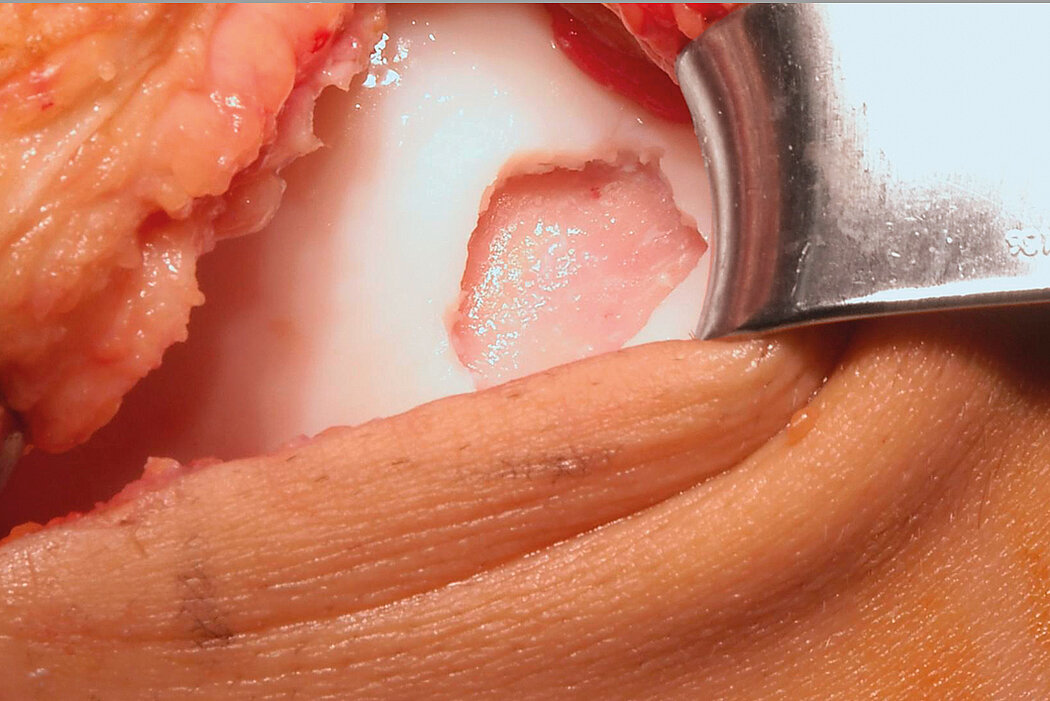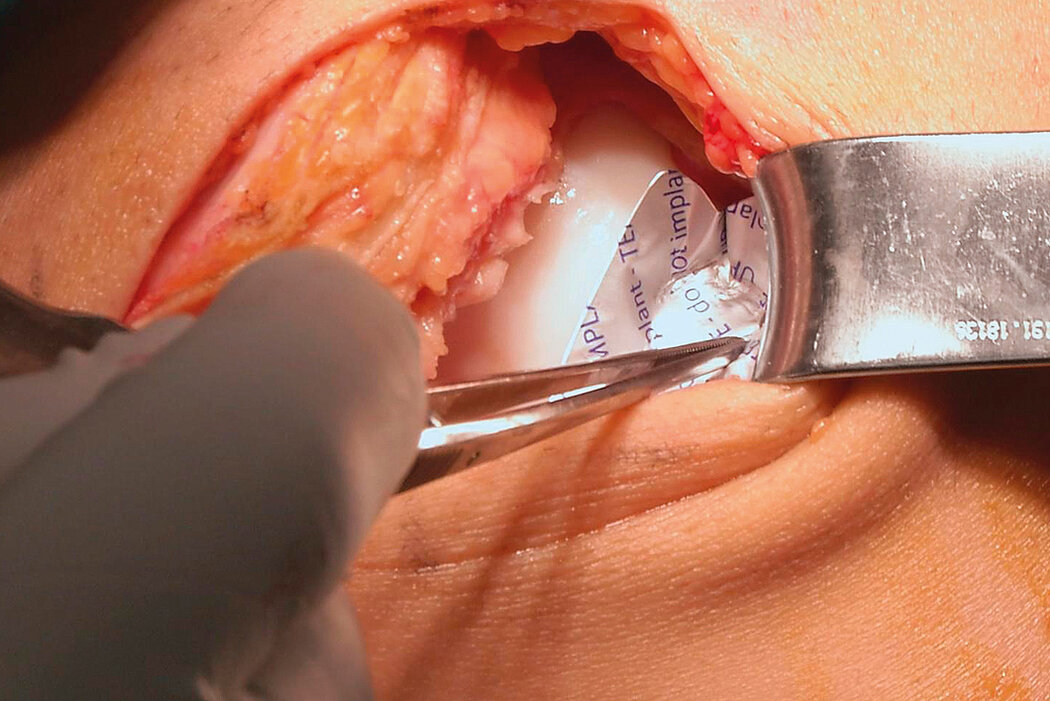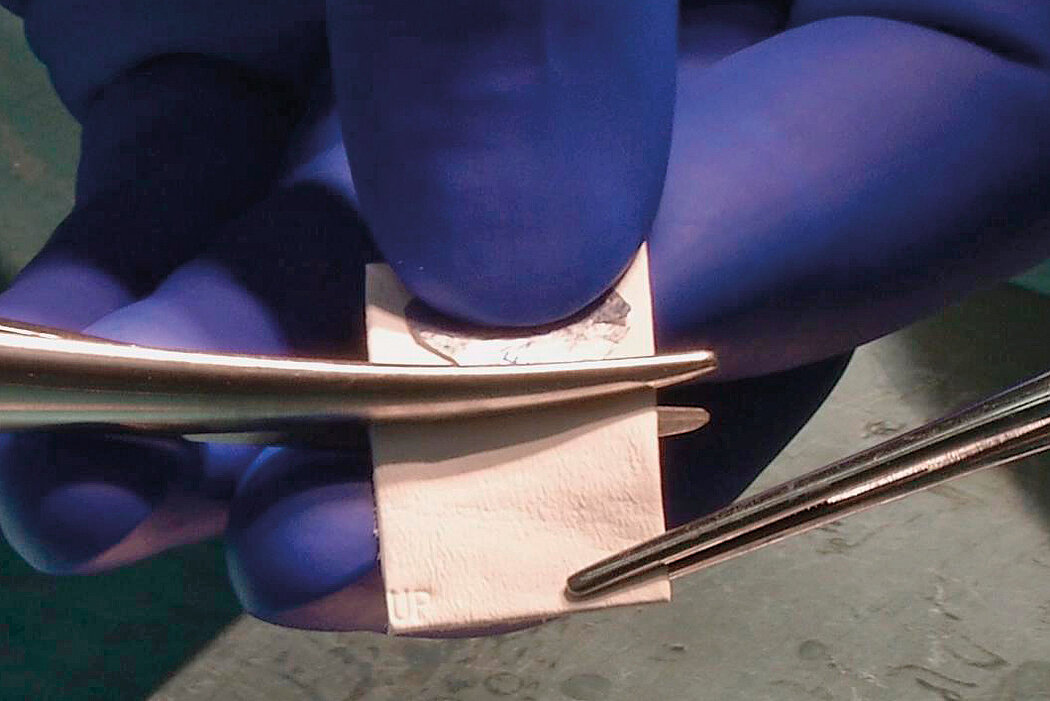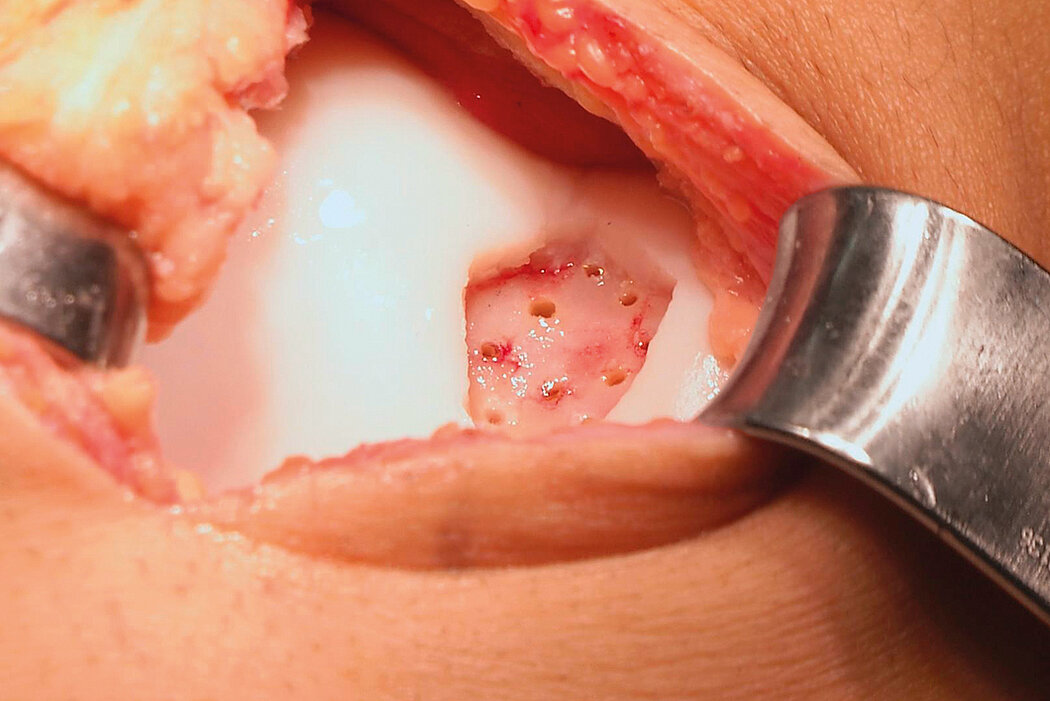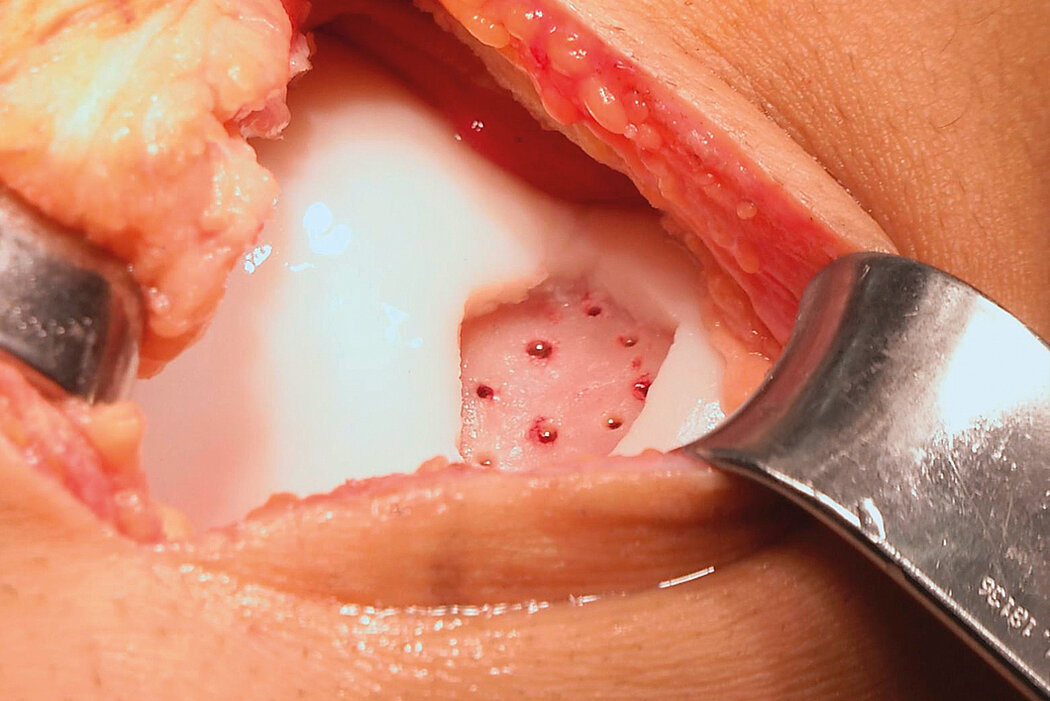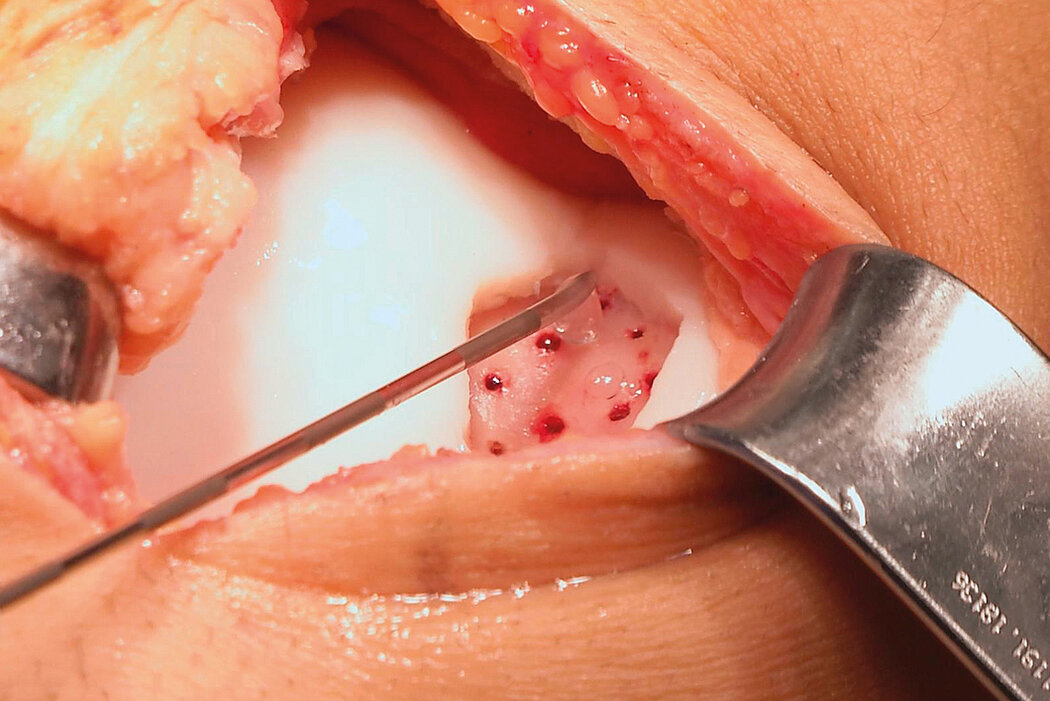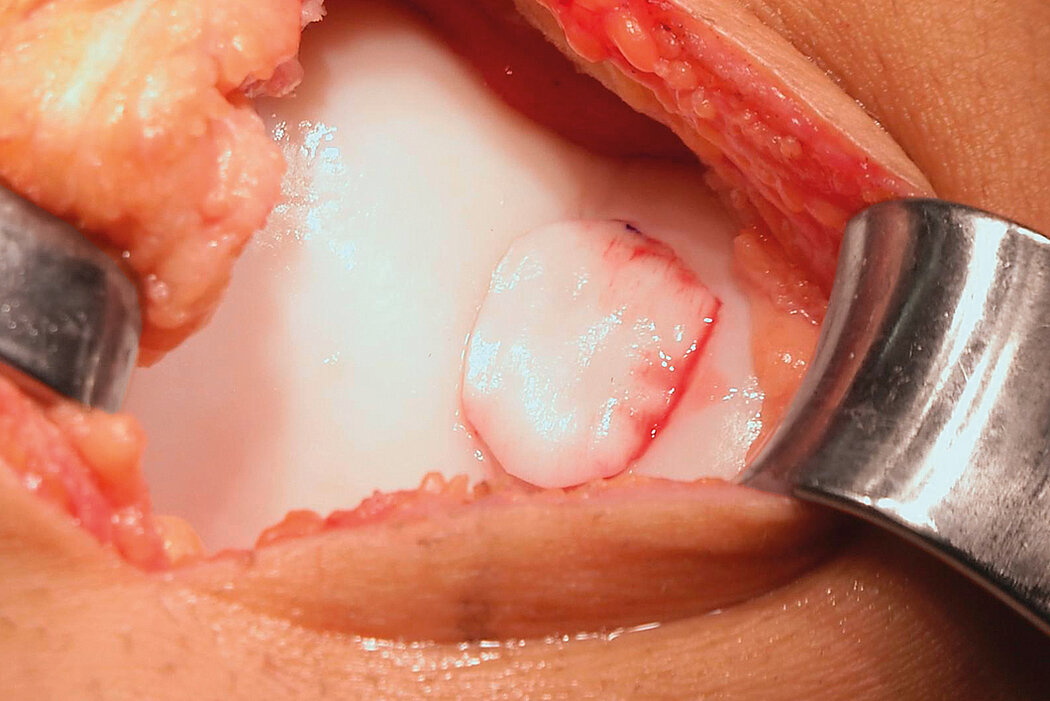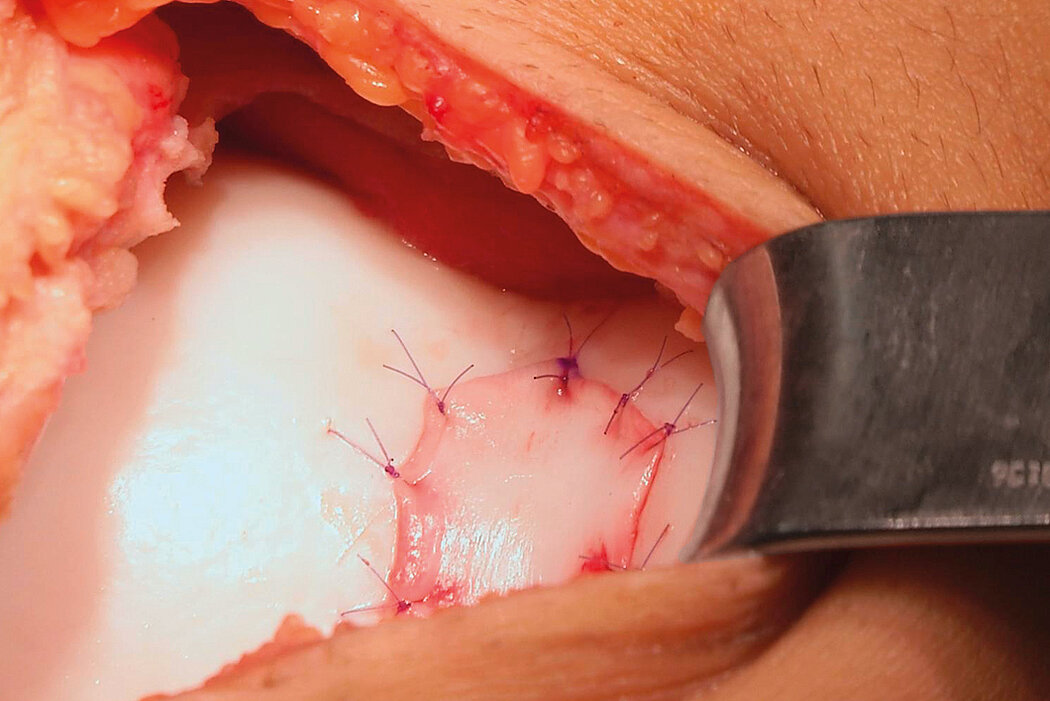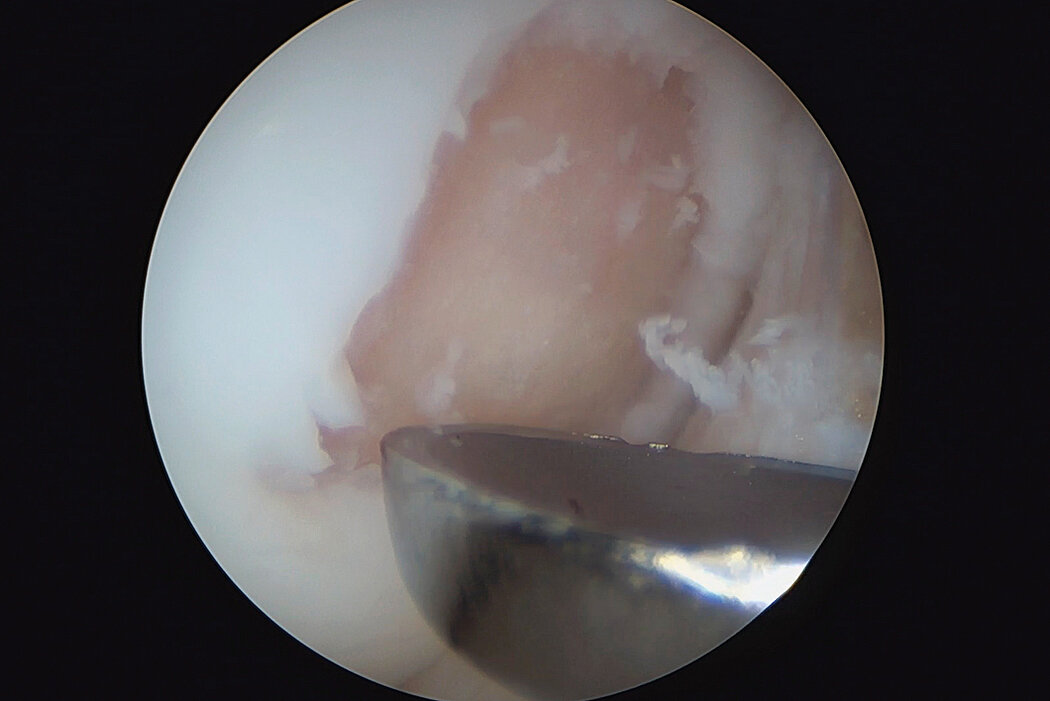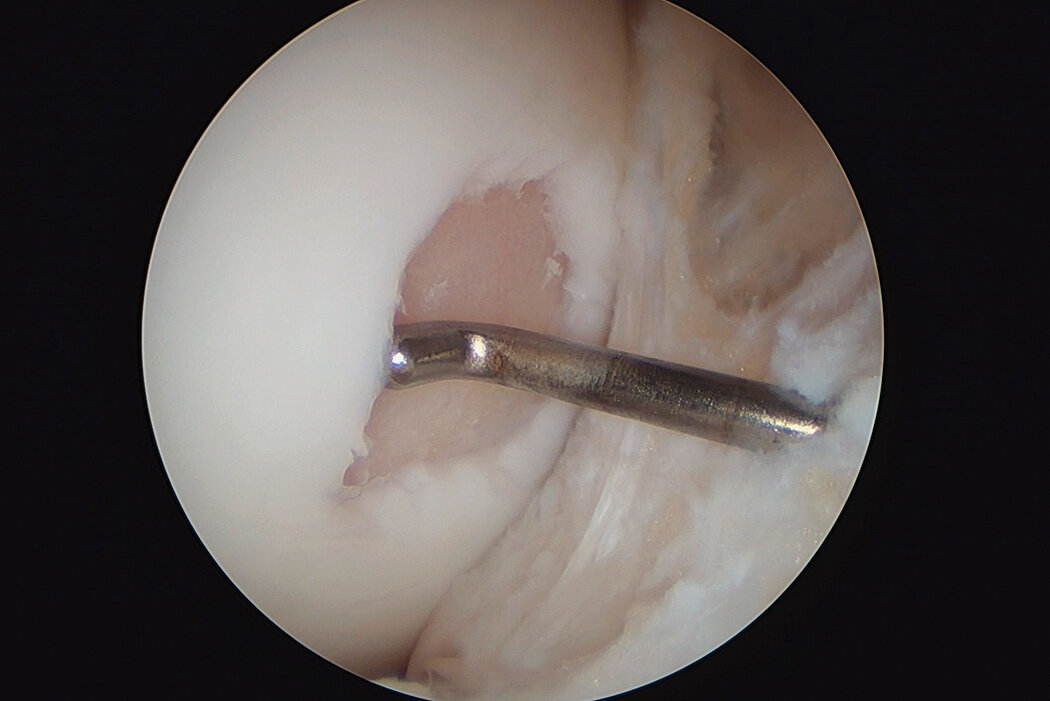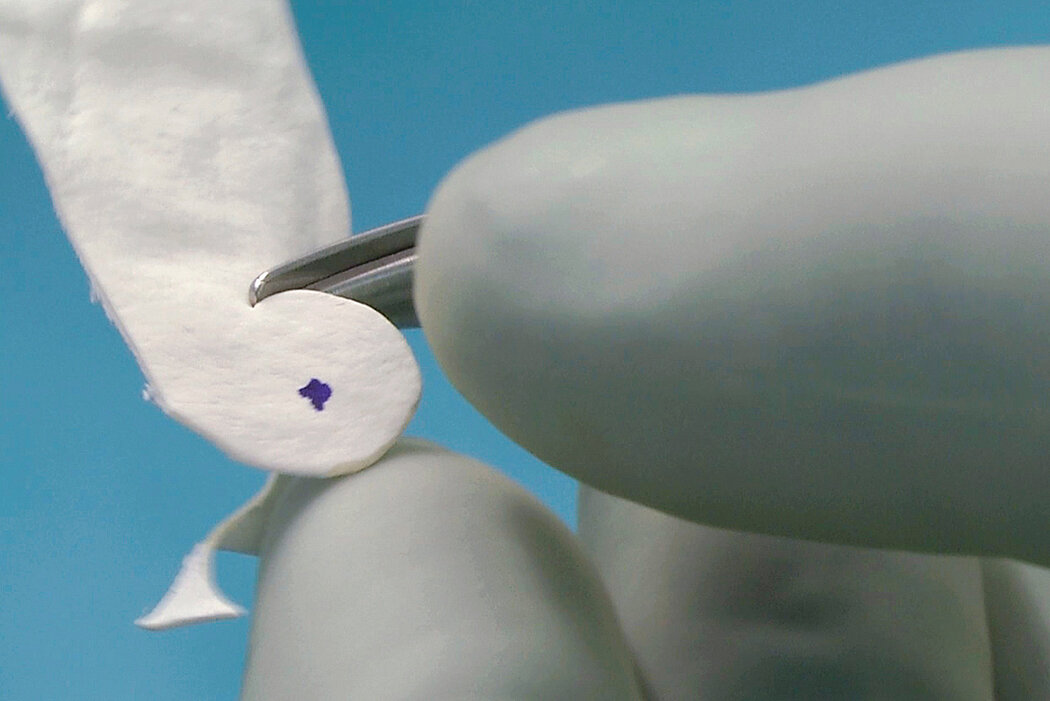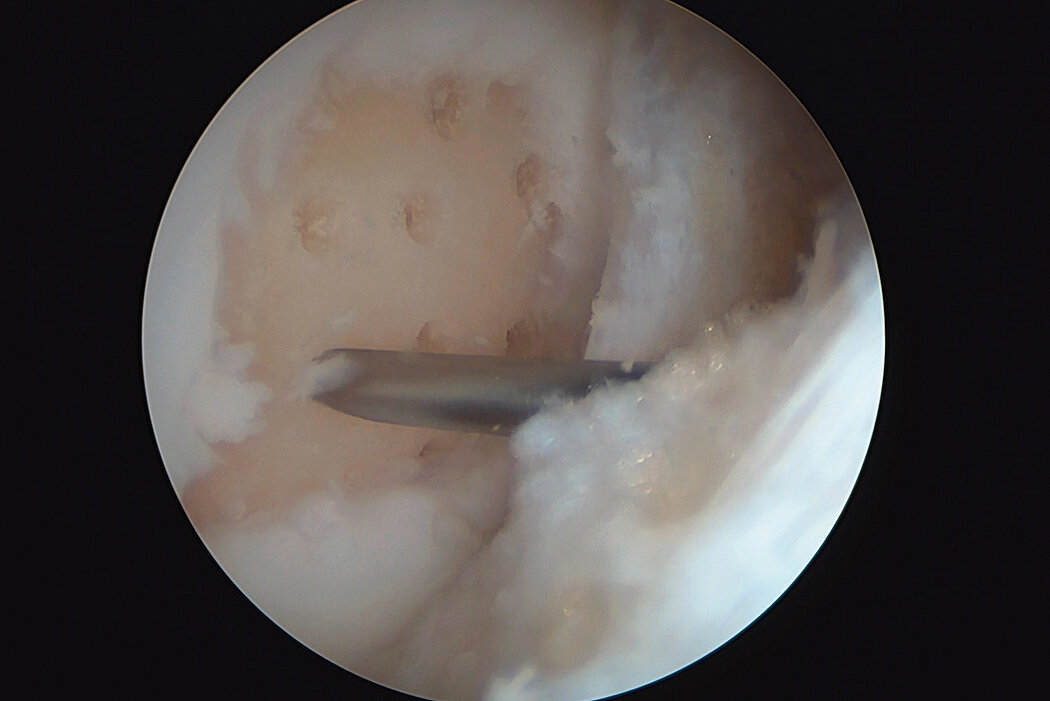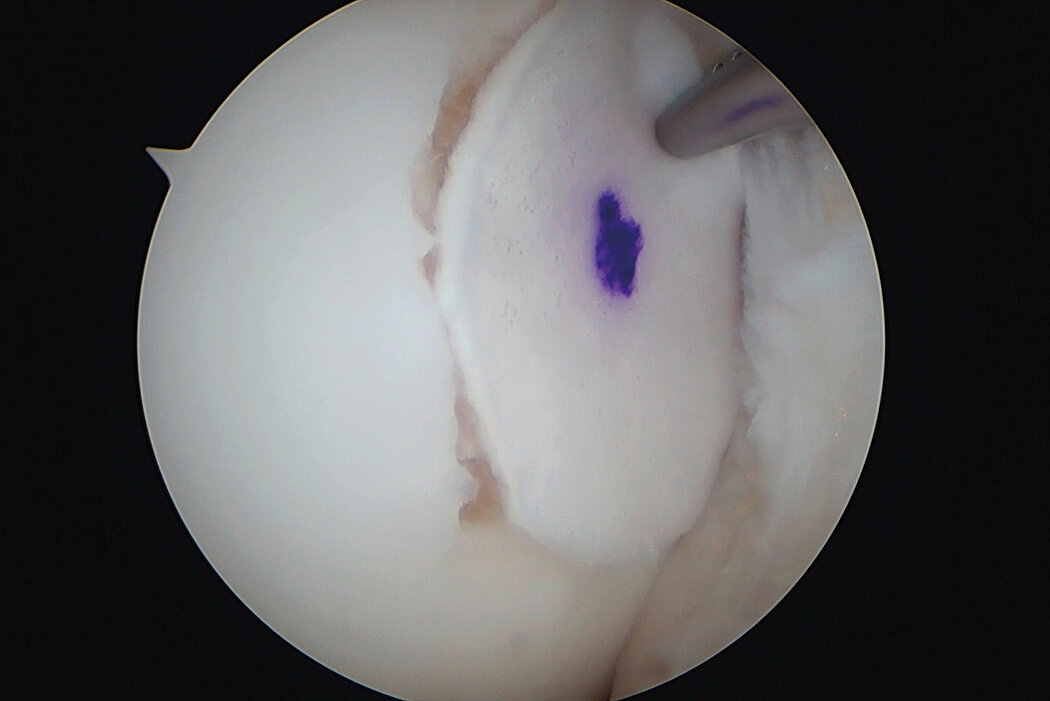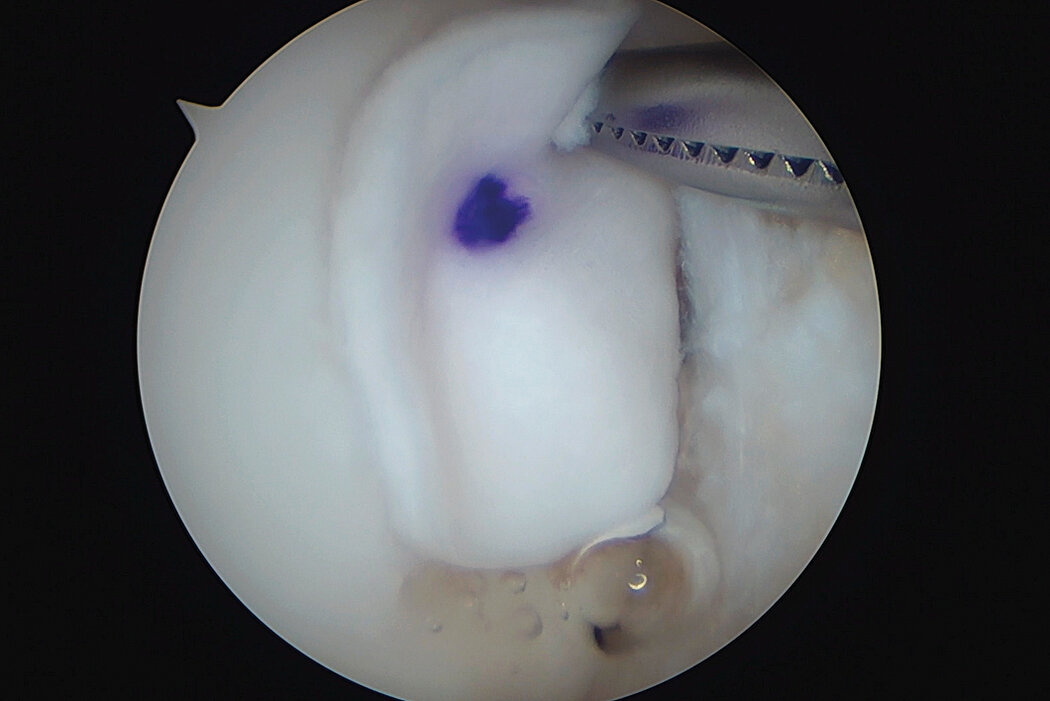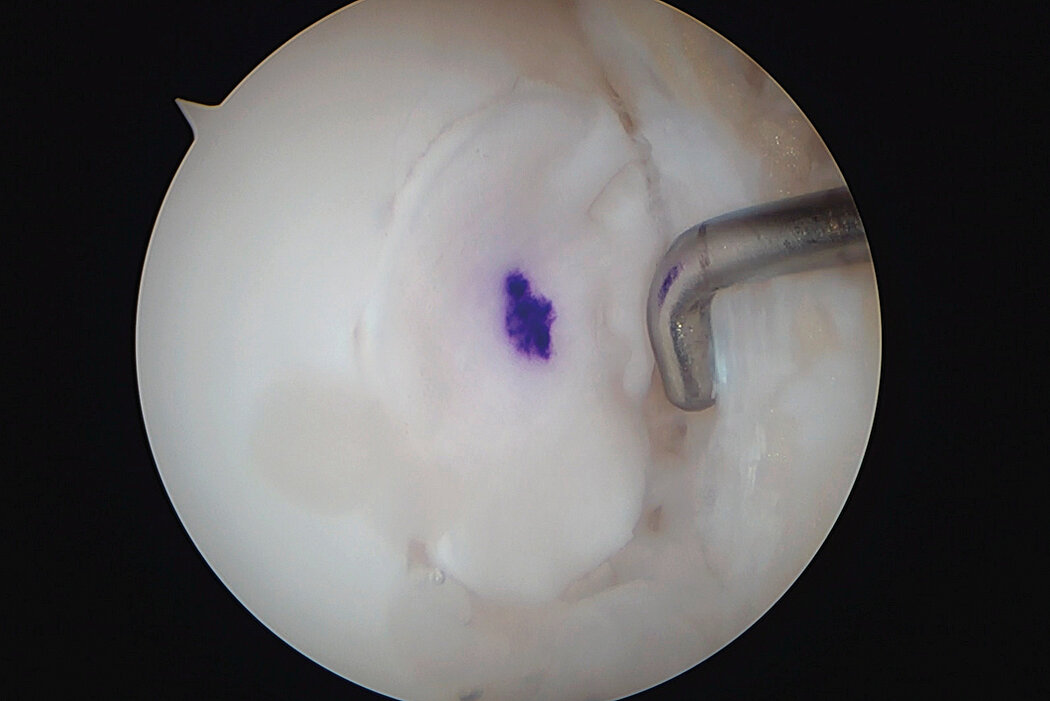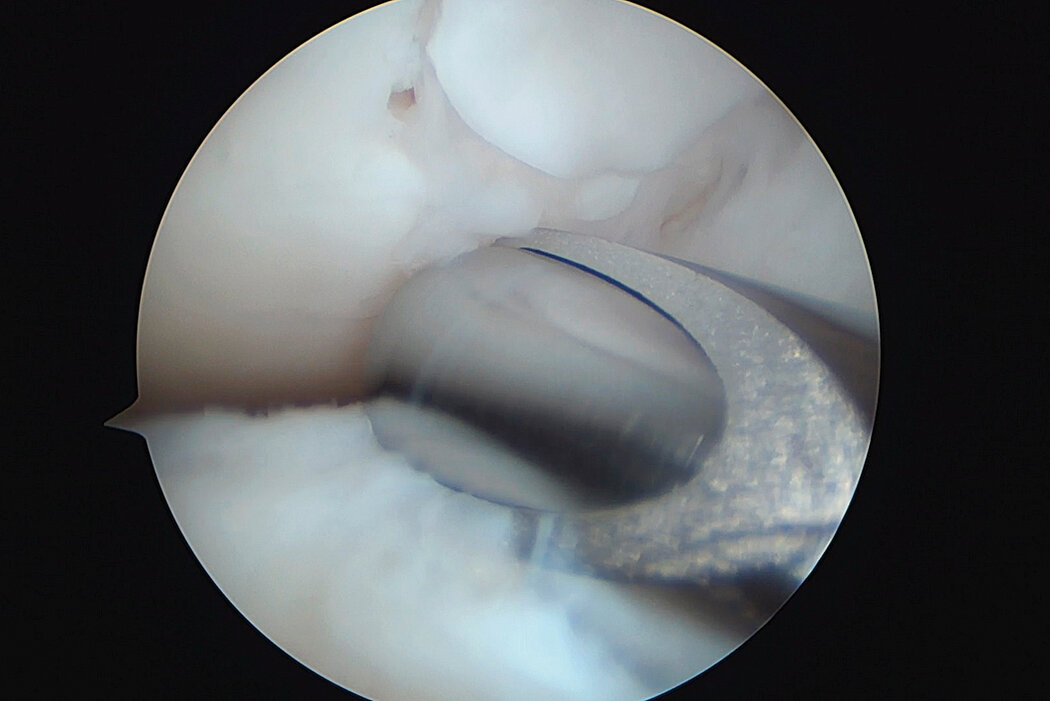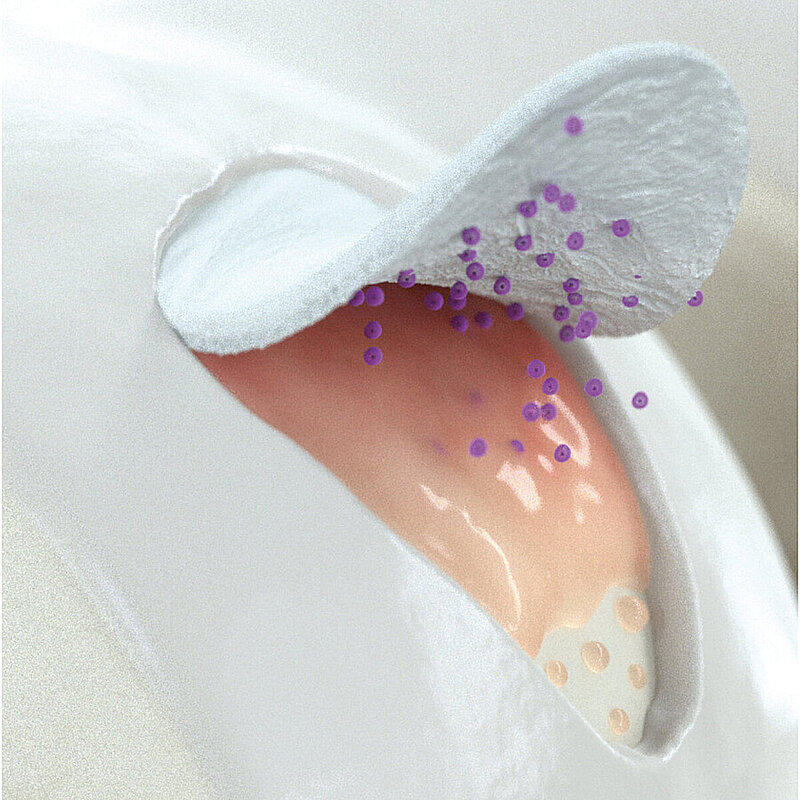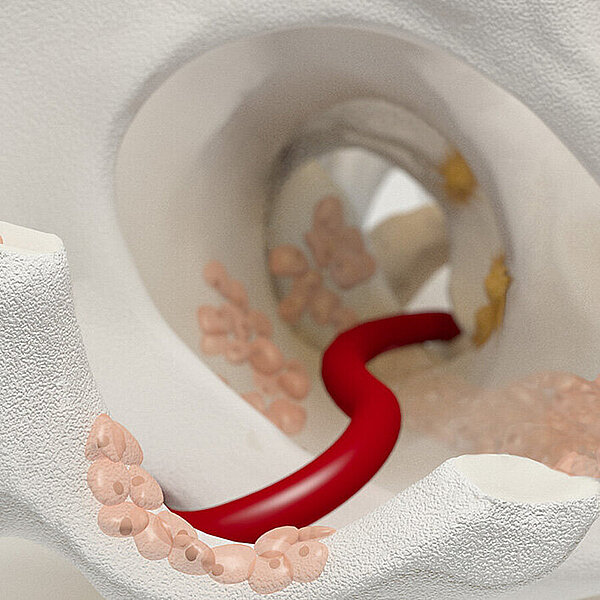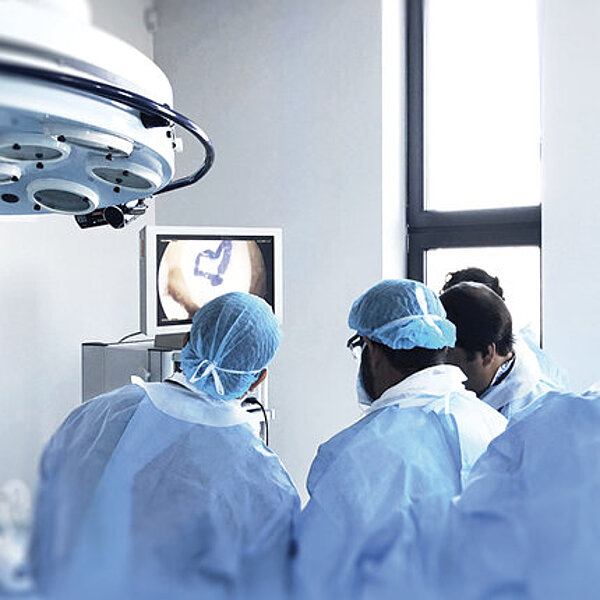AMIC® Chondro-Gide® nel ginocchio
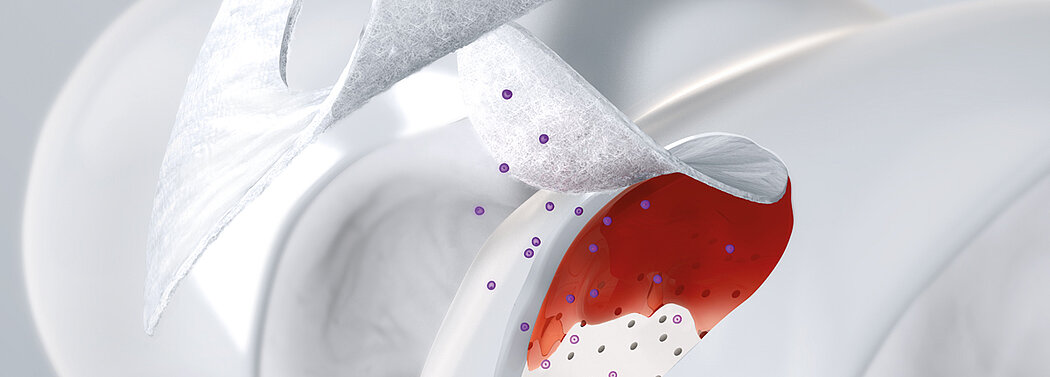
AMIC® Chondro-Gide® è una procedura minimamente invasiva a singolo step che usa la Condrogenesi Autologa Indotta da Matrice (AMIC®) combinata con Chondro-Gide® nella riparazione dei difetti cartilaginei. Supportata da più di 10 ani di successi clinici, AMIC® Chondro-Gide® è un trattamento efficace e economico1-3 per la riparazione della cartilagine danneggiata del ginocchio, alleviando o prevenendo il dolore e rallentando la progressione del danno.
AMIC® Chondro-Gide® combina le Microfratture (MFx) con l’uso di Chondro-Gide® che copre e protegge sia il coagulo proveniente dalle MFX che la riparazione tissutale4. Può essere fatta sia in chirurgia mini-open che in artroscopia. Biocompatibile e completamente riassorbibile, Chondro-Gide® supporta il potenziale fisiologico di guarigione.
Vantaggi
Con la sua speciale stuttura doppio strato, Chondro-Gide® fornisce un ambiente protettivo che favorisce la crescita di nuovo tessuto5,6.
- Membrana di collagene naturale I/III doppio strato5
- Biocompatibile e naturalmente riassorbibile5
- Facile da maneggiare: flessibile e resistente alle lacerazioni5
- Può essere stabilizzata con colla di fibrina in situ5
- Compatibile con varie tecniche di rigenerazione tissutale7
- Procedura one-step5
- Pronta per l’uso5
References
- SCHIAVONE PANNI, A., et al. Good clinical results with autologous matrix-induced chondrogenesis (Amic) technique in large knee chondral defects. Knee Surg Sports Traumatol Arthrosc, 2018 Apr 26(4):1130-36 (Clinical study)
- WALTHER, M., et al. Scaffold based reconstruction of focal full thickness talar cartilage defects. Clinical Research on Foot & Ankle, 2013, 1-5. (Clinical study)
- KAISER, N., et al. Clinical results 10 years after AMIC in the knee. Swiss Med Wkly, 2015, 145 (Suppl 210), 43S. (Clinical study)
- VOLZ, M., et al. A randomized controlled trial demonstrating sustained benefit of Autologous Matrix-Induced Chondrogenesis over microfracture at five years. Int Orthop, Apr 2017, 41(4), 797-804. (Clinical study)
- Geistlich Pharma AG data on file (Bench test)
- GILLE, J., et al. Cell-Laden and Cell-Free Matrix-Induced-Chondrogenesis versus Microfracture for the Treatment of Articular Cartilage Defects: A Histological and Biomechanical Study in Sheep. Cartilage OnlineFirst, January 7, 2010, doi:10.1177/1947603509358721 (Pre-clinical study)
- KRAMER, J., et al. In vivo matrix-guided human mesenchymal stem cells. Cell Mol Life Sci, Mar 2006, 63(5), 616-626. (Clinical study)
- MITHOEFER, K., et al. The microfracture technique for the sustained benefit of Autologous Matrix-Induced Chondrogenesis over microfracture at five years. Int Orthop, Apr 2017, 41(4), 797-804. (Clinical study)
- GOYAL, D., et al. Evidence-based status of microfracture technique: a systematic review of level I and II studies. Arthroscopy, Sep 2013, 29(9), 1579-1588. (Review of clinical studies)
- FONTANA, A., et al. Sustained five-year benefit of autologous matrix-induced chondrogenesis for femoral acetabular impingement-induced chondral lesions compared with microfracture treatment. Bone Joint J, May 2015, 97-B(5), 628-635. (Clinical study)
- GAO, L., et al. Early loss of subchondral bone following microfracture is counteracted by bone marrow aspirate in a translational model of osteochondral repair. Nature Scientif-ic Reports, 2017, 7:45189, DOI: 10.1038/srep45189 (Pre-clinical study)
- FRANK, R.M., et al., Failure of Bone Marrow Stimulation Techniques, Sports Med Arthrosc Rev, 2017, 25 (1) (Review of clinical studies)
- STEADMAN, J.R., Microfracture Technique for Full-Thickness Chondral Defects: Technique and Clinical Results. Operative Techniques in Orthopaedics. 1997. 7(4), 300-304. (Clinical study)
- KAISER, N., et al. Clinical results 10 years after AMIC in the knee. Swiss Med Wkly, 2015, 145 (Suppl 210), 43S. (Clinical study)
- VOLZ, M., et al. A randomized controlled trial demonstrating sustained benefit of Autologous Matrix-Induced Chondrogenesis over microfracture at five years. Int Orthop, Apr 2017, 41(4), 797-804. (Clinical study)
- SCHAGEMANN, J., et al. Mid-term outcome of arthroscopic AMIC for the treatment of articular cartilage defects in the knee joint is equivalent to mini-open procedures. Arch Orthop Trauma Surg, Jan 22 2018. (Clinical study)
- STEINWACHS, M.R.,et al. Systematic Review and Meta-Analysis of the Clinical Evidence on the Use of Autologous Matrix-Induced Chondrogenesis in the Knee. Cartilage. 2019:1947603519870846. https://www.ncbi.nlm.nih.gov/ pubmed/31508990 (Review of clinical studies)
- FOSSUM, V., et al. Collagen-Covered Autologous Chondrocyte Implantation Versus Autologous Matrix-Induced Chondrogenesis: A Randomized Trial Comparing 2 Methods for Repair of Cartilage Defects of the Knee. Orthopaedic Journal of Sports Medicine. 019;7(9):2325967119868212. doi.org/10.1177/2325967119868212 (Clinical study)
References
- SCHIAVONE PANNI, A., et al. Good clinical results with autologous matrix-induced chondrogenesis (Amic) technique in large knee chondral defects. Knee Surg Sports Traumatol Arthrosc, 2018 Apr 26(4):1130-36 (Clinical study)
- WALTHER, M., et al. Scaffold based reconstruction of focal full thickness talar cartilage defects. Clinical Research on Foot & Ankle, 2013, 1-5. (Clinical study)
- KAISER, N., et al. Clinical results 10 years after AMIC in the knee. Swiss Med Wkly, 2015, 145 (Suppl 210), 43S. (Clinical study)
- VOLZ, M., et al. A randomized controlled trial demonstrating sustained benefit of Autologous Matrix-Induced Chondrogenesis over microfracture at five years. Int Orthop, Apr 2017, 41(4), 797-804. (Clinical study)
- Geistlich Pharma AG data on file (Bench test)
- GILLE, J., et al. Cell-Laden and Cell-Free Matrix-Induced-Chondrogenesis versus Microfracture for the Treatment of Articular Cartilage Defects: A Histological and Biomechanical Study in Sheep. Cartilage OnlineFirst, January 7, 2010, doi:10.1177/1947603509358721 (Pre-clinical study)
- KRAMER, J., et al. In vivo matrix-guided human mesenchymal stem cells. Cell Mol Life Sci, Mar 2006, 63(5), 616-626. (Clinical study)
- MITHOEFER, K., et al. The microfracture technique for the sustained benefit of Autologous Matrix-Induced Chondrogenesis over microfracture at five years. Int Orthop, Apr 2017, 41(4), 797-804. (Clinical study)
- GOYAL, D., et al. Evidence-based status of microfracture technique: a systematic review of level I and II studies. Arthroscopy, Sep 2013, 29(9), 1579-1588. (Review of clinical studies)
- FONTANA, A., et al. Sustained five-year benefit of autologous matrix-induced chondrogenesis for femoral acetabular impingement-induced chondral lesions compared with microfracture treatment. Bone Joint J, May 2015, 97-B(5), 628-635. (Clinical study)
- GAO, L., et al. Early loss of subchondral bone following microfracture is counteracted by bone marrow aspirate in a translational model of osteochondral repair. Nature Scientif-ic Reports, 2017, 7:45189, DOI: 10.1038/srep45189 (Pre-clinical study)
- FRANK, R.M., et al., Failure of Bone Marrow Stimulation Techniques, Sports Med Arthrosc Rev, 2017, 25 (1) (Review of clinical studies)
- STEADMAN, J.R., Microfracture Technique for Full-Thickness Chondral Defects: Technique and Clinical Results. Operative Techniques in Orthopaedics. 1997. 7(4), 300-304. (Clinical study)
- KAISER, N., et al. Clinical results 10 years after AMIC in the knee. Swiss Med Wkly, 2015, 145 (Suppl 210), 43S. (Clinical study)
- VOLZ, M., et al. A randomized controlled trial demonstrating sustained benefit of Autologous Matrix-Induced Chondrogenesis over microfracture at five years. Int Orthop, Apr 2017, 41(4), 797-804. (Clinical study)
- SCHAGEMANN, J., et al. Mid-term outcome of arthroscopic AMIC for the treatment of articular cartilage defects in the knee joint is equivalent to mini-open procedures. Arch Orthop Trauma Surg, Jan 22 2018. (Clinical study)
- STEINWACHS, M.R.,et al. Systematic Review and Meta-Analysis of the Clinical Evidence on the Use of Autologous Matrix-Induced Chondrogenesis in the Knee. Cartilage. 2019:1947603519870846. https://www.ncbi.nlm.nih.gov/ pubmed/31508990 (Review of clinical studies)
- FOSSUM, V., et al. Collagen-Covered Autologous Chondrocyte Implantation Versus Autologous Matrix-Induced Chondrogenesis: A Randomized Trial Comparing 2 Methods for Repair of Cartilage Defects of the Knee. Orthopaedic Journal of Sports Medicine. 019;7(9):2325967119868212. doi.org/10.1177/2325967119868212 (Clinical study)
Tecnica chirurgica in Mini-Open, Dr. M. Steinwachs
References
- SCHIAVONE PANNI, A., et al. Good clinical results with autologous matrix-induced chondrogenesis (Amic) technique in large knee chondral defects. Knee Surg Sports Traumatol Arthrosc, 2018 Apr 26(4):1130-36 (Clinical study)
- WALTHER, M., et al. Scaffold based reconstruction of focal full thickness talar cartilage defects. Clinical Research on Foot & Ankle, 2013, 1-5. (Clinical study)
- KAISER, N., et al. Clinical results 10 years after AMIC in the knee. Swiss Med Wkly, 2015, 145 (Suppl 210), 43S. (Clinical study)
- VOLZ, M., et al. A randomized controlled trial demonstrating sustained benefit of Autologous Matrix-Induced Chondrogenesis over microfracture at five years. Int Orthop, Apr 2017, 41(4), 797-804. (Clinical study)
- Geistlich Pharma AG data on file (Bench test)
- GILLE, J., et al. Cell-Laden and Cell-Free Matrix-Induced-Chondrogenesis versus Microfracture for the Treatment of Articular Cartilage Defects: A Histological and Biomechanical Study in Sheep. Cartilage OnlineFirst, January 7, 2010, doi:10.1177/1947603509358721 (Pre-clinical study)
- KRAMER, J., et al. In vivo matrix-guided human mesenchymal stem cells. Cell Mol Life Sci, Mar 2006, 63(5), 616-626. (Clinical study)
- MITHOEFER, K., et al. The microfracture technique for the sustained benefit of Autologous Matrix-Induced Chondrogenesis over microfracture at five years. Int Orthop, Apr 2017, 41(4), 797-804. (Clinical study)
- GOYAL, D., et al. Evidence-based status of microfracture technique: a systematic review of level I and II studies. Arthroscopy, Sep 2013, 29(9), 1579-1588. (Review of clinical studies)
- FONTANA, A., et al. Sustained five-year benefit of autologous matrix-induced chondrogenesis for femoral acetabular impingement-induced chondral lesions compared with microfracture treatment. Bone Joint J, May 2015, 97-B(5), 628-635. (Clinical study)
- GAO, L., et al. Early loss of subchondral bone following microfracture is counteracted by bone marrow aspirate in a translational model of osteochondral repair. Nature Scientif-ic Reports, 2017, 7:45189, DOI: 10.1038/srep45189 (Pre-clinical study)
- FRANK, R.M., et al., Failure of Bone Marrow Stimulation Techniques, Sports Med Arthrosc Rev, 2017, 25 (1) (Review of clinical studies)
- STEADMAN, J.R., Microfracture Technique for Full-Thickness Chondral Defects: Technique and Clinical Results. Operative Techniques in Orthopaedics. 1997. 7(4), 300-304. (Clinical study)
- KAISER, N., et al. Clinical results 10 years after AMIC in the knee. Swiss Med Wkly, 2015, 145 (Suppl 210), 43S. (Clinical study)
- VOLZ, M., et al. A randomized controlled trial demonstrating sustained benefit of Autologous Matrix-Induced Chondrogenesis over microfracture at five years. Int Orthop, Apr 2017, 41(4), 797-804. (Clinical study)
- SCHAGEMANN, J., et al. Mid-term outcome of arthroscopic AMIC for the treatment of articular cartilage defects in the knee joint is equivalent to mini-open procedures. Arch Orthop Trauma Surg, Jan 22 2018. (Clinical study)
- STEINWACHS, M.R.,et al. Systematic Review and Meta-Analysis of the Clinical Evidence on the Use of Autologous Matrix-Induced Chondrogenesis in the Knee. Cartilage. 2019:1947603519870846. https://www.ncbi.nlm.nih.gov/ pubmed/31508990 (Review of clinical studies)
- FOSSUM, V., et al. Collagen-Covered Autologous Chondrocyte Implantation Versus Autologous Matrix-Induced Chondrogenesis: A Randomized Trial Comparing 2 Methods for Repair of Cartilage Defects of the Knee. Orthopaedic Journal of Sports Medicine. 019;7(9):2325967119868212. doi.org/10.1177/2325967119868212 (Clinical study)
Tecnica chirurgia in artroscopia, prof. Dr. Justus Gille
References
- SCHIAVONE PANNI, A., et al. Good clinical results with autologous matrix-induced chondrogenesis (Amic) technique in large knee chondral defects. Knee Surg Sports Traumatol Arthrosc, 2018 Apr 26(4):1130-36 (Clinical study)
- WALTHER, M., et al. Scaffold based reconstruction of focal full thickness talar cartilage defects. Clinical Research on Foot & Ankle, 2013, 1-5. (Clinical study)
- KAISER, N., et al. Clinical results 10 years after AMIC in the knee. Swiss Med Wkly, 2015, 145 (Suppl 210), 43S. (Clinical study)
- VOLZ, M., et al. A randomized controlled trial demonstrating sustained benefit of Autologous Matrix-Induced Chondrogenesis over microfracture at five years. Int Orthop, Apr 2017, 41(4), 797-804. (Clinical study)
- Geistlich Pharma AG data on file (Bench test)
- GILLE, J., et al. Cell-Laden and Cell-Free Matrix-Induced-Chondrogenesis versus Microfracture for the Treatment of Articular Cartilage Defects: A Histological and Biomechanical Study in Sheep. Cartilage OnlineFirst, January 7, 2010, doi:10.1177/1947603509358721 (Pre-clinical study)
- KRAMER, J., et al. In vivo matrix-guided human mesenchymal stem cells. Cell Mol Life Sci, Mar 2006, 63(5), 616-626. (Clinical study)
- MITHOEFER, K., et al. The microfracture technique for the sustained benefit of Autologous Matrix-Induced Chondrogenesis over microfracture at five years. Int Orthop, Apr 2017, 41(4), 797-804. (Clinical study)
- GOYAL, D., et al. Evidence-based status of microfracture technique: a systematic review of level I and II studies. Arthroscopy, Sep 2013, 29(9), 1579-1588. (Review of clinical studies)
- FONTANA, A., et al. Sustained five-year benefit of autologous matrix-induced chondrogenesis for femoral acetabular impingement-induced chondral lesions compared with microfracture treatment. Bone Joint J, May 2015, 97-B(5), 628-635. (Clinical study)
- GAO, L., et al. Early loss of subchondral bone following microfracture is counteracted by bone marrow aspirate in a translational model of osteochondral repair. Nature Scientif-ic Reports, 2017, 7:45189, DOI: 10.1038/srep45189 (Pre-clinical study)
- FRANK, R.M., et al., Failure of Bone Marrow Stimulation Techniques, Sports Med Arthrosc Rev, 2017, 25 (1) (Review of clinical studies)
- STEADMAN, J.R., Microfracture Technique for Full-Thickness Chondral Defects: Technique and Clinical Results. Operative Techniques in Orthopaedics. 1997. 7(4), 300-304. (Clinical study)
- KAISER, N., et al. Clinical results 10 years after AMIC in the knee. Swiss Med Wkly, 2015, 145 (Suppl 210), 43S. (Clinical study)
- VOLZ, M., et al. A randomized controlled trial demonstrating sustained benefit of Autologous Matrix-Induced Chondrogenesis over microfracture at five years. Int Orthop, Apr 2017, 41(4), 797-804. (Clinical study)
- SCHAGEMANN, J., et al. Mid-term outcome of arthroscopic AMIC for the treatment of articular cartilage defects in the knee joint is equivalent to mini-open procedures. Arch Orthop Trauma Surg, Jan 22 2018. (Clinical study)
- STEINWACHS, M.R.,et al. Systematic Review and Meta-Analysis of the Clinical Evidence on the Use of Autologous Matrix-Induced Chondrogenesis in the Knee. Cartilage. 2019:1947603519870846. https://www.ncbi.nlm.nih.gov/ pubmed/31508990 (Review of clinical studies)
- FOSSUM, V., et al. Collagen-Covered Autologous Chondrocyte Implantation Versus Autologous Matrix-Induced Chondrogenesis: A Randomized Trial Comparing 2 Methods for Repair of Cartilage Defects of the Knee. Orthopaedic Journal of Sports Medicine. 019;7(9):2325967119868212. doi.org/10.1177/2325967119868212 (Clinical study)
Evidenza clinica su AMIC® nel ginocchio
AMIC® Chondro-Gide® si è dimostrata essere un trattamento efficace nella riparazione di lesioni cartilaginea nel ginocchio. Studi clinici mostrano il successo del trattamento con AMIC® Chondro-Gide® sia con chirurgia mini-open che con tecniche artroscopiche per oltre 10 anni14.
Migliore performance rispetto alle sole Microfratture (MFx), dopo 2 anni
In uno studio controllato randomizzato a 3 gruppi con 47 pazienti in due centri15, è stata visto un significativo peggioramento del risultato dopo 2 anni dal trattamento con solo MicroFratture (MFx) (senza Chondro-Gide®). Sia il dolore che i valori funzionali (ICRS e Valori di Cincinnati modificati) rimanevano stabili o addirittura miglioravano con AMIC®, mentre dolore e valori funzionali peggioravano per il gruppo MFx.
References
- SCHIAVONE PANNI, A., et al. Good clinical results with autologous matrix-induced chondrogenesis (Amic) technique in large knee chondral defects. Knee Surg Sports Traumatol Arthrosc, 2018 Apr 26(4):1130-36 (Clinical study)
- WALTHER, M., et al. Scaffold based reconstruction of focal full thickness talar cartilage defects. Clinical Research on Foot & Ankle, 2013, 1-5. (Clinical study)
- KAISER, N., et al. Clinical results 10 years after AMIC in the knee. Swiss Med Wkly, 2015, 145 (Suppl 210), 43S. (Clinical study)
- VOLZ, M., et al. A randomized controlled trial demonstrating sustained benefit of Autologous Matrix-Induced Chondrogenesis over microfracture at five years. Int Orthop, Apr 2017, 41(4), 797-804. (Clinical study)
- Geistlich Pharma AG data on file (Bench test)
- GILLE, J., et al. Cell-Laden and Cell-Free Matrix-Induced-Chondrogenesis versus Microfracture for the Treatment of Articular Cartilage Defects: A Histological and Biomechanical Study in Sheep. Cartilage OnlineFirst, January 7, 2010, doi:10.1177/1947603509358721 (Pre-clinical study)
- KRAMER, J., et al. In vivo matrix-guided human mesenchymal stem cells. Cell Mol Life Sci, Mar 2006, 63(5), 616-626. (Clinical study)
- MITHOEFER, K., et al. The microfracture technique for the sustained benefit of Autologous Matrix-Induced Chondrogenesis over microfracture at five years. Int Orthop, Apr 2017, 41(4), 797-804. (Clinical study)
- GOYAL, D., et al. Evidence-based status of microfracture technique: a systematic review of level I and II studies. Arthroscopy, Sep 2013, 29(9), 1579-1588. (Review of clinical studies)
- FONTANA, A., et al. Sustained five-year benefit of autologous matrix-induced chondrogenesis for femoral acetabular impingement-induced chondral lesions compared with microfracture treatment. Bone Joint J, May 2015, 97-B(5), 628-635. (Clinical study)
- GAO, L., et al. Early loss of subchondral bone following microfracture is counteracted by bone marrow aspirate in a translational model of osteochondral repair. Nature Scientif-ic Reports, 2017, 7:45189, DOI: 10.1038/srep45189 (Pre-clinical study)
- FRANK, R.M., et al., Failure of Bone Marrow Stimulation Techniques, Sports Med Arthrosc Rev, 2017, 25 (1) (Review of clinical studies)
- STEADMAN, J.R., Microfracture Technique for Full-Thickness Chondral Defects: Technique and Clinical Results. Operative Techniques in Orthopaedics. 1997. 7(4), 300-304. (Clinical study)
- KAISER, N., et al. Clinical results 10 years after AMIC in the knee. Swiss Med Wkly, 2015, 145 (Suppl 210), 43S. (Clinical study)
- VOLZ, M., et al. A randomized controlled trial demonstrating sustained benefit of Autologous Matrix-Induced Chondrogenesis over microfracture at five years. Int Orthop, Apr 2017, 41(4), 797-804. (Clinical study)
- SCHAGEMANN, J., et al. Mid-term outcome of arthroscopic AMIC for the treatment of articular cartilage defects in the knee joint is equivalent to mini-open procedures. Arch Orthop Trauma Surg, Jan 22 2018. (Clinical study)
- STEINWACHS, M.R.,et al. Systematic Review and Meta-Analysis of the Clinical Evidence on the Use of Autologous Matrix-Induced Chondrogenesis in the Knee. Cartilage. 2019:1947603519870846. https://www.ncbi.nlm.nih.gov/ pubmed/31508990 (Review of clinical studies)
- FOSSUM, V., et al. Collagen-Covered Autologous Chondrocyte Implantation Versus Autologous Matrix-Induced Chondrogenesis: A Randomized Trial Comparing 2 Methods for Repair of Cartilage Defects of the Knee. Orthopaedic Journal of Sports Medicine. 019;7(9):2325967119868212. doi.org/10.1177/2325967119868212 (Clinical study)
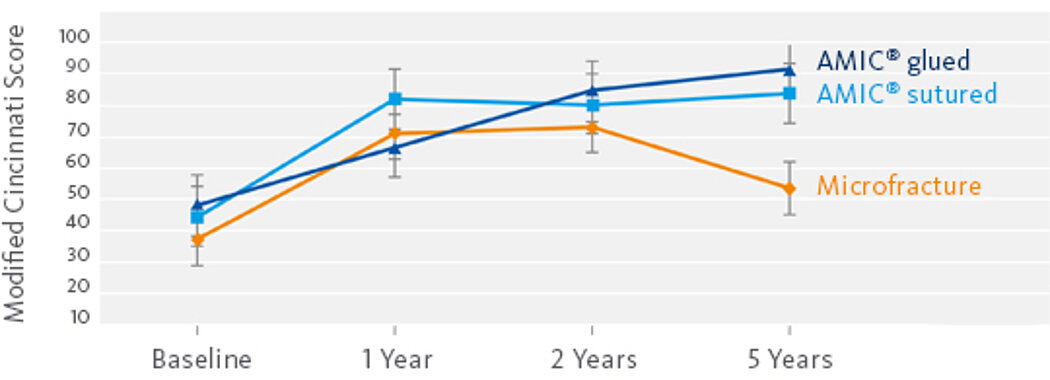
Artroscopia o mini-artrotomia, entrambe danno buoni risultati
In uno studio retrospettivo, Schagemann et al.16 hanno confrontato i risultati clinici delle procedure di AMIC® Chondro-Gide® eseguite in artroscopia o chirurgia mini-open, in pazienti seguiti fino a 2 anni. In base alla ’ Visual Analog Scale' (VAS) dei pazienti, Lysholm scores, e Knee injury and Osteoarthrithis Outcome Scores (KOOS), entrambi gli approcci chirurgici hanno permesso di ottenere buoni risultati.
Prima Meta-analisi di 12 studi su AMIC® Chondro-Gide® su 375 pazienti
Recentemente (2019) in una revisione sistematica e meta-analisi sui risultati ottenuti con AMIC®, gli autori hanno valutato lesioni condrali e osteocondrali di grado III/IV nel ginocchio con una dimensione del difetto media di 4.24 cm2 con più di 7 anni di follow-up.
L’uso della AMIC® Chondro-Gide® per difetti di dimensione tale che siano sopra la soglia raccomandata per le MFx, riduce significativamente il dolore e migliora la funzione dal baseline al follow-up. La meta-analisi documenta che la procedura AMIC® Chondro-Gide® migliora significativamente i risultati relativi a dolore e funzionalità nelle articolazioni del ginocchio con lesioni condrali o osteocondrali. I risultati inoltre dimostrano che il miglioramento è stato mantenuto per più di 5 anni, a conferma del successo a lungo termine della procedura AMIC® Chondro-Gide® nelle lesioni maggiori di grado III (> 4 cm2) e di grado IV17.
ACI-C e AMIC® Chondro-Gide® forniscono buoni risultati dopo 2 anni
Fossum et al. (2019) hanno condotto uno studio prospettico controllato randomizzato per valutare i risultati delle tecniche ACI-C e AMIC® nei difetti condrali e osteocondrali del femore distale e patella. Non ci sono differenze significative tra i risultati ottenuti con ACI-C e AMIC® a 1 e 2 anni.
Gli autori concludono che AMIC® può essere considerata un’alternativa a ACI-C sovrapponibile dal punto di vista clinico ma meno costosa in quanto AMIC® è a singolo step e quindi molto meno dispensiosa in termini di risorse18.
References
- SCHIAVONE PANNI, A., et al. Good clinical results with autologous matrix-induced chondrogenesis (Amic) technique in large knee chondral defects. Knee Surg Sports Traumatol Arthrosc, 2018 Apr 26(4):1130-36 (Clinical study)
- WALTHER, M., et al. Scaffold based reconstruction of focal full thickness talar cartilage defects. Clinical Research on Foot & Ankle, 2013, 1-5. (Clinical study)
- KAISER, N., et al. Clinical results 10 years after AMIC in the knee. Swiss Med Wkly, 2015, 145 (Suppl 210), 43S. (Clinical study)
- VOLZ, M., et al. A randomized controlled trial demonstrating sustained benefit of Autologous Matrix-Induced Chondrogenesis over microfracture at five years. Int Orthop, Apr 2017, 41(4), 797-804. (Clinical study)
- Geistlich Pharma AG data on file (Bench test)
- GILLE, J., et al. Cell-Laden and Cell-Free Matrix-Induced-Chondrogenesis versus Microfracture for the Treatment of Articular Cartilage Defects: A Histological and Biomechanical Study in Sheep. Cartilage OnlineFirst, January 7, 2010, doi:10.1177/1947603509358721 (Pre-clinical study)
- KRAMER, J., et al. In vivo matrix-guided human mesenchymal stem cells. Cell Mol Life Sci, Mar 2006, 63(5), 616-626. (Clinical study)
- MITHOEFER, K., et al. The microfracture technique for the sustained benefit of Autologous Matrix-Induced Chondrogenesis over microfracture at five years. Int Orthop, Apr 2017, 41(4), 797-804. (Clinical study)
- GOYAL, D., et al. Evidence-based status of microfracture technique: a systematic review of level I and II studies. Arthroscopy, Sep 2013, 29(9), 1579-1588. (Review of clinical studies)
- FONTANA, A., et al. Sustained five-year benefit of autologous matrix-induced chondrogenesis for femoral acetabular impingement-induced chondral lesions compared with microfracture treatment. Bone Joint J, May 2015, 97-B(5), 628-635. (Clinical study)
- GAO, L., et al. Early loss of subchondral bone following microfracture is counteracted by bone marrow aspirate in a translational model of osteochondral repair. Nature Scientif-ic Reports, 2017, 7:45189, DOI: 10.1038/srep45189 (Pre-clinical study)
- FRANK, R.M., et al., Failure of Bone Marrow Stimulation Techniques, Sports Med Arthrosc Rev, 2017, 25 (1) (Review of clinical studies)
- STEADMAN, J.R., Microfracture Technique for Full-Thickness Chondral Defects: Technique and Clinical Results. Operative Techniques in Orthopaedics. 1997. 7(4), 300-304. (Clinical study)
- KAISER, N., et al. Clinical results 10 years after AMIC in the knee. Swiss Med Wkly, 2015, 145 (Suppl 210), 43S. (Clinical study)
- VOLZ, M., et al. A randomized controlled trial demonstrating sustained benefit of Autologous Matrix-Induced Chondrogenesis over microfracture at five years. Int Orthop, Apr 2017, 41(4), 797-804. (Clinical study)
- SCHAGEMANN, J., et al. Mid-term outcome of arthroscopic AMIC for the treatment of articular cartilage defects in the knee joint is equivalent to mini-open procedures. Arch Orthop Trauma Surg, Jan 22 2018. (Clinical study)
- STEINWACHS, M.R.,et al. Systematic Review and Meta-Analysis of the Clinical Evidence on the Use of Autologous Matrix-Induced Chondrogenesis in the Knee. Cartilage. 2019:1947603519870846. https://www.ncbi.nlm.nih.gov/ pubmed/31508990 (Review of clinical studies)
- FOSSUM, V., et al. Collagen-Covered Autologous Chondrocyte Implantation Versus Autologous Matrix-Induced Chondrogenesis: A Randomized Trial Comparing 2 Methods for Repair of Cartilage Defects of the Knee. Orthopaedic Journal of Sports Medicine. 019;7(9):2325967119868212. doi.org/10.1177/2325967119868212 (Clinical study)

